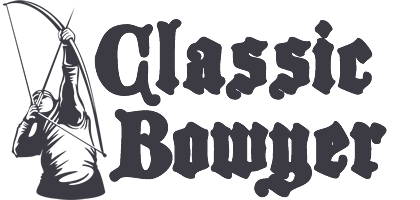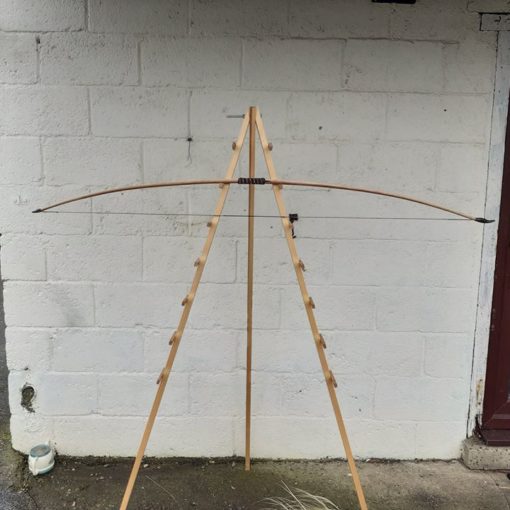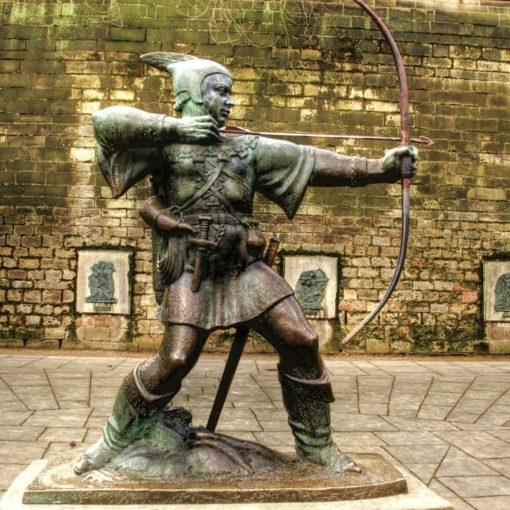
This has always been a favourite point of speculation and discussion regarding the medieval longbow. It is also one in which people often have much-cherished and fiercely defended points of view – frequently with little or no supporting evidence. With all traditional archery cultures, you tend to get two schools of thought – among those who love to theorise, which are as follows: The ‘Heavy Bow brigade’, and the ‘Light Bow brigade’. The former of these like to suggest that the bows used by military archers in the past were immensely heavy. They sometimes even suggest draw weights could reach as much as 500lb! This is by no means a new phenomenon, Thomas Roberts in ‘The English Bowman’ writes describing Persian bows as drawing 500lb. It is highly unlikely that there has ever been a man on Earth who could have used a 500lb bow.
Prior to the salvage of the Mary Rose and the wonderfully preserved Tudor bows within her, most estimates of the draw weight for the English medieval bow were in the region of 80lb to 100lb. Now that real evidence is emerging from examination of these well preserved artifacts this has been revised up somewhat. Much highly technologically sophisticated analysis has been carried out on the Mary Rose artefacts and very expertly made replicas have been produced by highly competent and accomplished bowyers from the best yew wood obtainable today. The result of this work has given draw weights among the Mary Rose bows as ranging from about 80lb at the very lightest to about 180lb at the heaviest. These weights are an absolute potential range going from the shortest arrows in the smallest bows up to the longest arrows in the biggest bows. Among the statistical scatter of the draw weights there are two clusters – one at just over 100lb and the other just above 140lb *citation*. Some now in the ‘The Heavy-Bow brigade’, in their pontifications purport that the medieval longbow averaged 200lb draw-weight! While they represent a minority of archers who shoot in the heavy bow, there are those who have a ‘machismo’ attitude to it and like to make it a condition that one has to be macho enough i.e. shoot a heavy enough bow to be a member of their select group of ‘real’ warbow archers.
By contrast, the ‘Light-Bow brigade’ suggest the opposite i.e that we are vastly over-estimating the draw weights of the old bows. Just precisely what evidence they draw this conclusion from is quite baffling. It may even be that a kind of envy may play a part in that because they can’t use bows of this weight, no-one really can or could have done. Possibly if archers feeling like this actually took the trouble to learn the correct technique, they may find that in fact they can use a heavy bow at or approaching Tudor warbow weight (and thus remove the cause of their denial?).
It has been suggested that the nocks of the Mary Rose arrows are too small to take the size of string required for the kind of draw-weights suggested for the bows. However, this takes no account of string technology of the time. It is looking like the kind of strings we use on our bows today may not be representative of the kind used in medieval and Tudor times. The strings we use today with heavy longbows are made of the immensely strong modern materials Kevlar (‘Fastflite’) and UHMW polyethylene (‘Dyneema’) and usually made into the single-loop flemish twist. There is evidence that this style of string actually is more recent and post-dates the era of the heavy warbow. Natural fibre such as hemp or flax / linen does indeed have to be very thick to stand in a bow drawing in excess of 100lb, if it is made in the fashion of a modern flemish twist string. However, research carried out recently suggests strings may indeed have been made which are strong enough for the heavy draw weights and thin enough to fit the nocks of the Mary Rose arrows. These strings have been either plaited for their entire length (rather than just at the ends in the typical Flemish Twist string today) or indeed served for their entire length in the manner of a medieval crossbow string.
So, today we are at least obtaining some reliable data regarding warbow draw weights. Ongoing work is progressing in practical archery with societies such as the EWBS to ascertain what kind of performance can realistically be attained with bows in the weight range of around 80lb to 190lb, and to see how it compares with what can be made of ancient descriptions of archery performance. However, the Mary Rose if we want to be strictly logical about this, only tells about one batch of bows on one ship at one particular time and in one particular type of situation.
The Mary Rose sank in 1545 on a naval action in the Solent against French invaders. It was at a time of transition in military hardware. The Mary Rose had a sophisticated weapon system comprising elements both from the past (and on the way out) and those becoming newly adopted. She carried quite primitive medieval-style forged, breach loading cannons and hackbut type swivel guns. But she also carried cast bronze, muzzle loading cannons which were not improved upon until the 19th century. Replicas have shown these cannon were capable of supersonic muzzle velocity and could destroy another vessel several miles away. Ammunition varied from iron and stone ball to very large arrow-like projectiles – the most primitive form of ammunition dating back to the earliest firearms. She was the flagship sailing at the head of a navy belonging to a king who was also a passionate military archery enthusiast. So, what can we conclude from these facts about the Mary Rose bows and arrows?
All of the weapons on board, when looked at as a whole appear to have worked together as an integrated weapon-system. The archery really needs to be viewed in this context. If you were to approach the Mary Rose intending to attack, or indeed if she were to sail towards you aggressively you would have come under the onslaught of the range of weapons in order. Firstly, the powerful long range cast bronze cannon would open fire hoping to destroy or disable your vessel over a mile away. Then as distance closed to a few hundred yards you would also come under fire from the comparatively rapid fire breach-loading, forged iron cannon. At this point you could well have also started to experience arrow storms from the archers creating mayhem on deck killing and wounding crew. Then closer still, the small calibre swivel guns would open up adding to the punishment. Possibly closest of all you would be fired upon by what is arguably the nastiest of the Mary Rose’s weapons – square-bore cannon. These very short barrelled guns fired lethal lead ‘dice’ which would rip up wood and flesh with their edges and corners – but which would have had next to zero accuracy. The cubic shot could kick off in any direction on leaving the muzzle but would be fired at such close range that this would not be a concern – a hit on something was almost guaranteed. The final stage, if you were still afloat would be the boarding party, which would very likely have included archers.
As described above the archery fitted in to the scheme of weaponry on board in a sea combat situation, as well as having a function in any land action the vessel may have been supporting. It is certain that the archers had a role in sea battles as there are dedicated positions for archers identifiable on the upper deck.
We also need to remember, she was the king’s flagship, so it is probably fair to conclude that the equipment and personnel on board were of the highest calibre obtainable. They are likely to be first class examples of the bows of the day and the archers would have been the equivalent possibly of the SAS. You would not have any Tom, Dick or Harry using indifferent equipment serving on this ship. So, we might be looking at the finest, strongest bows used by the cream of the archers of the time. I do not mean to suggest however that more average archers would use much weaker bows. Modern warbow archers have proved that mature men who have not had early heavy-bow training in life can certainly master bows in the lower weight range of the Mary Rose weapons with the right training. Probably we can tentatively presume the average archer would shoot bows somewhat, on average a bit less strong than those on the Mary Rose.
Yet more questions arise as to where the Mary Rose longbows stand in comparison to their medieval ancestors. The Mary Rose bows are not medieval bows, they are Tudor bows. How similar were they to the weapons of Henry V used at Agincourt 130 years before and at Crecy nearly 70 years before that? We regard the high Middle-Ages, the time of the Plantagenet kings as the heyday of the longbow. The Tudor era was the twilight of the longbow. By 1545, it was rapidly dying out. As mentioned above, military fashions were changing, the old was giving way to the new. This was not just in the military sphere as large social and economic changes in their way also were hastening the change away from the old ways. Bows and arrows, armour, archers and knights were giving way to cannons, muskets and gunnery. However at this time the old and emerging new were often woven together in a synergy that Henry VIII saw as valuable and sought to preserve.
Until we are lucky enough to find genuine specimens of bows from the real medieval period (which sadly is unlikely), we just will not know for certain how similar they were to the Mary Rose bows. It seems reasonable to assume that they may not have been much different as the wooden longbow is very likely to have been a mature technology for a few centuries by 1545 and simply could not go any further. Medieval illustrations do not show them as looking much different, though there is a limit as to how much you can base on medieval art. There are those who think that the bows of the Hundred Years War were more powerful as this was the heyday of the military longbow. Ascham also mentions general discontent among military experts regarding the decline of the power of English archery in his time, the mid 16th century. However he seems to be specifically referring to the growth of so-called ‘prick shooting’, the fore runner of target archery, which drew the complaints because it distracted men from learning and developing real strong archery useful in war. Instead it encouraged the use of lighter draw weights which enabled greater accuracy shooting at targets. In his famous work ‘Toxophilus’ Roger Ascham describes both war archery and the more genteel recreational archery. Both existed at his time and it is important to be aware about which one he is specifically talking about at any point in the book. It is not always easy to disentangle these two threads and indeed at his time the two sides of longbow shooting would very likely to have had more things in common than today when they have become more polarised.
It is also possible to argue that the warbows of Henry VIII’s time may have been more powerful as they were now possibly more specialised. Bowyers and arrow makers had always been engaged in an arms-race with armourers since the middle ages and the emerging firearms may have been a complicating factor here. Armour, before it was abandoned was further strengthened to resist firearms and the metallurgy of armour was possibly at its peak by the mid 16th century. Bowyers and arrowsmiths may have attempted to produce archery equipment capable of piercing this newer stronger armour, but this is all speculation with no real evidence.
One piece of material evidence we may have regarding the strength of medieval bows is a single arrow which could be medieval. Until it is carbon-dated we will not know what age it is. The arrow in question is the Westminster Abbey arrow which was found during renovation work in the 19th century. It is more or less certain that it is not a Victorian forgery as it has design features characteristic of a proper warbow arrow and as we have discussed earlier, victorian romantics did not have much idea what real warbows were like. This arrow is slightly lighter and more graceful than the arrows found on the Mary Rose, but it is also not likely to have been representative of the heaviest war arrows used. We cannot be certain exactly what type of arrow it was and as I mentioned until we know its age we can not draw any conclusions from it. So far the Dean of Chapter of Westminster Abbey frustratingly will not allow a small sample of wood to be taken from it (which could be done in such a way as to be invisible) for dating. Rough estimates for the kind of bow which would have suited this arrow have been in the range of 100lb to 140lb. The author has made approximations of this arrow has found it to be a very good arrow that flies well and to good distance and that actually suits a wide range of bow weights.




